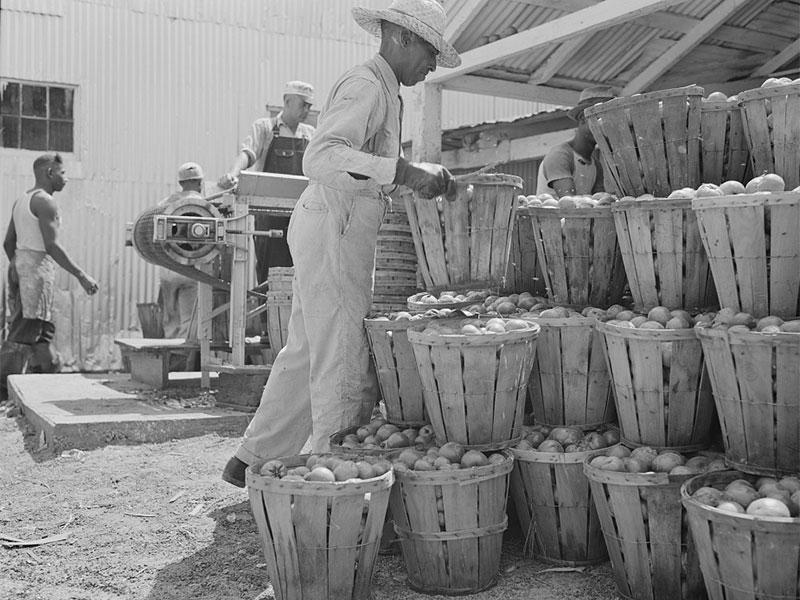The Phillips Packing Company began in Cambridge, Maryland in 1902 with a single plant and went on to become the largest employer in Dorchester County and one of the most recognized names in seafood. As the company expanded so did its legacy on the Eastern Shore through buildings and stories, and now there is a new opportunity to revitalize a former packing plant.
When Albanus Phillips, Levi Phillips, and W.G. Winterbottom established the Phillips Packing Company in 1902, they probably did not imagine that it would grow into a Phillips empire. Today, there are five restaurants along the east coast, seafood packing plants all over the world and Phillips brand foods being sold in stores across the country – and it all started in Cambridge, Maryland.

Fruit canning process. Photo from Library of Congress.
Fruit and vegetables
Packing Plant F, located in Cambridge Maryland, was the largest fruit cannery in the United States. Aside from fruit, it canned sweet potatoes, lima beans, white potatoes, and tomatoes. In fact, the tomato canning won Cambridge the nickname, “Tomato Capital of the World.” During World Wars I and II, the packing company was the largest supplier of individual canned and pre-cooked meals, known as C-Rations in the country, and in World War II, employed approximately 1/4 of all of the 8,000 Cambridge residents. The plant also supplied foods to Admiral Richard Byrd, a friend of Albanus Phillips, for his Antarctic expeditions in the 1930s. The Phillips company eventually expanded into trucking and oil, which further spurred economic growth in Cambridge. Packing Plant F was family-owned and run until 1956, when the company was sold to Consolidated Foods, now Sara Lee Corporation.
Seafood
Still an operating packing plant, Packing Plant B, located on Hoopers Island in the Chesapeake Bay, opened in 1917 and employed approximately 25 women as crab pickers, along with employees to package crabmeat, soft crab, and oysters. Brice R. Phillips, son of Albanus Phillips, began selling surplus crabs from the plant out of a pickup truck in busy Ocean City, Maryland. Looking to expand even further, Brice and his wife, Sherry, used traditional Hoopers Island recipes and opened their first crab shack in 1956 with just four seats – it became a local institution that grew to seat 1400 people.
Additional restaurants were opened along the East Coast, including ones in Baltimore, Atlantic City, and various airports and casinos, and distributed their seafood, crab soup, crab cakes, clam chowder, and tartar sauce to stores and restaurants throughout the area. Today, their son, Steve Phillips, is the CEO of Phillips Foods Inc., and Phillips Seafood Restaurants and manages the company’s operations.
TIME FOR REVITALIZATION

Sen. Cardin at the Phillips Packing Plant historic tax credit project, 2017.
The plan to rehabilitate the Phillips Packing Plant F received a Maryland Heritage Structure Rehabilitation Competitive Commercial Tax Credit recently. The Eastern Shore Land Conservancy and Cross Street Partners are working together to rehabilitate and renovate the structure into The Packing House, mixed-use space for a food and farming exchange, connecting long history with addressing a current need. The new space will feature a microbrewery and brewpub, an oyster bar, and office space for various non-profit organizations and companies.
LEARN MORE ABOUT HISTORIC TAX CREDITS
SUPPORT PRESERVATION MARYLAND’s ADVOCACY FUND
This post was written by Maggie Pelta-Pauls, a Waxter Intern with Preservation Maryland. A graduate of The College of William and Mary, Maggie is primed to research and write about Maryland history – especially culinary history. Learn more about Maggie and our The Waxter Memorial Internship program here: presmd.org/waxter.
